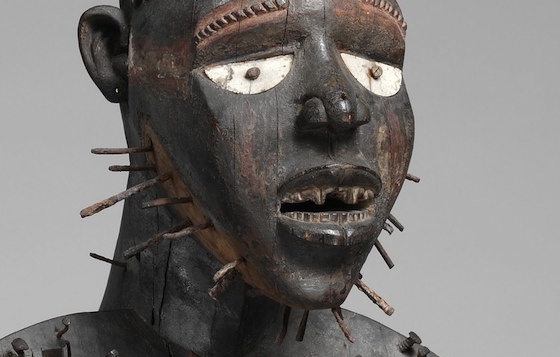The Mangaaka Power Figure, or Nkisi N’Kondi, stands as one of the most compelling artifacts of Central African art, embodying the intersection of spirituality, governance, and communal justice. This 19th-century masterpiece from the Kongo culture reflects a rich tradition of collaboration between sculptors and ritual specialists (nganga), highlighting the deep-rooted significance of art as a vessel for mystical power and societal order.
1. The Role of Power Figures in Kongo Culture
Power figures (nkisi) were central to the spiritual and judicial practices of the Kongo people. These sculptures were conceived as homes for mystical forces capable of influencing real-world outcomes. The Nkisi N’Kondi specifically functioned as a “hunter” of wrongdoings, used to resolve disputes, seal treaties, and enforce societal norms.
This collaboration between the artist and nganga was critical. The sculptor would create the physical form, while the ritual specialist imbued it with spiritual energy by inserting substances known as bilongo into a cavity, often located in the abdomen or head of the figure. These materials were believed to activate the figure’s power and connect it to the spiritual realm.
2. Mangaaka: The Supreme Force of Jurisprudence
The Mangaaka Power Figure belongs to the most ambitious class of Nkisi N’Kondi, associated with Mangaaka—a force symbolizing justice, leadership, and protection. Active in regions of modern-day Congo and Angola, workshops specializing in Mangaaka figures created them as embodiments of authority and governance. These figures were not mere objects; they served as communal protectors, guarding against evil and ensuring adherence to social codes.
The Symbolism of Mangaaka
- The Mpu Headdress: The figure is crowned with an mpu, a distinctive woven headdress traditionally worn by chiefs or priests. This headdress signifies the figure’s dual role as both a spiritual and political authority.
- Posture and Gesture: Leaning forward with hands on its hips, the figure’s aggressive stance communicates readiness to confront challenges. This posture embodies unwavering authority and a fearless commitment to justice.
- Nails and Metal Embellishments: The torso is embedded with nails, blades, and other metals, each marking a vow, treaty, or judicial act. These additions document the figure’s active role in mediating disputes and eradicating malevolence within the community.

Kongo peoples; Yombe group,
Wood, paint, metal, resin, ceramic; H. 46 1/2 in. (118 cm), W. 19 1/2 in. (49.5 cm), D. 15 1/2 in. (39.4 cm)
The Metropolitan Museum of Art, New York, Purchase, Lila Acheson Wallace, Drs. Daniel and Marian Malcolm, Laura G. and James J. Ross, Jeffrey B. Soref, The Robert T. Wall Family, Dr. and Mrs. Sidney G. Clyman, and Steven Kossak Gifts, 2008 (2008.30)
http://www.metmuseum.org/Collections/search-the-collections/320053
3. Artistic Features and Mystical Details
The Mangaaka Power Figure is a masterwork of both symbolism and craftsmanship. Every aspect of its design reflects layers of meaning:
Aesthetic Excellence
The figure’s robust form and intricate detailing demonstrate the technical prowess of Kongo sculptors. The remnants of a beard—indicated by nails along the chin—highlight seniority and wisdom, further reinforcing the figure’s status as a guiding authority.
Abdominal Cavity
Central to its mystical function, the figure originally featured an abdominal cavity filled with bilongo. This cavity acted as a reservoir for spiritual power, linking the physical figure to the divine. Over time, the cavity was often replenished during rituals, emphasizing the figure’s dynamic role in community life.
4. The Social and Ritual Impact
Power figures like the Mangaaka were far more than static artworks; they were integral to the social fabric of the Kongo people. Communities would gather around such figures during important ceremonies, using them to:
- Resolve conflicts and affirm alliances.
- Punish transgressors who violated moral or social codes.
- Protect against malevolent forces or spiritual harm.
Each ritual interaction reinforced the figure’s authority, transforming it into a living witness to the community’s collective actions and beliefs.

5. Reflection on Kongo Ideals of Justice
The Mangaaka Power Figure serves as a profound reflection of Kongo ideals, where art, spirituality, and governance are inextricably linked. Through its imposing presence, the figure reminded individuals of their obligations to the community, ensuring that justice prevailed and harmony was maintained.
This artifact invites modern audiences to consider the powerful role of material culture in shaping and sustaining societal values. It stands as a testament to the Kongo people’s deep understanding of justice—not merely as punishment but as a means of restoring balance and protecting the collective good.
Conclusion
The Mangaaka Power Figure is a remarkable example of African art’s ability to transcend aesthetics, becoming a living force within its community. As both a spiritual protector and an enforcer of justice, this figure exemplifies the Kongo culture’s integration of law, spirituality, and artistry. Its aggressive posture, intricate adornments, and mystical function highlight the profound ways in which material objects were imbued with power to shape societal order—a legacy that continues to inspire reflection on the intersections of art, authority, and belief.
